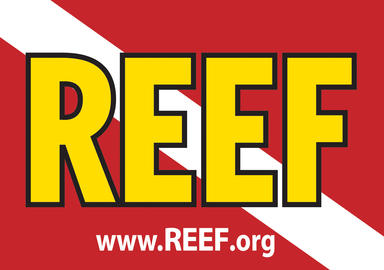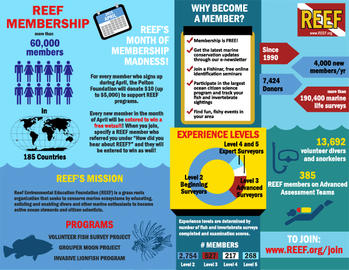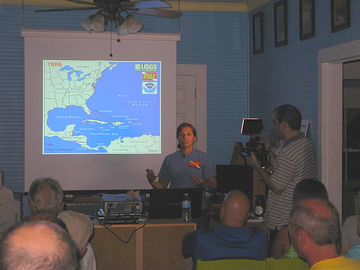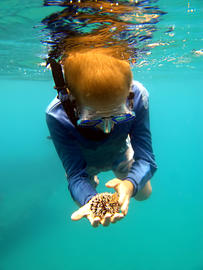We are excited to announce REEF Fest 2015, a celebration to be held this fall in Key Largo (September 24 - 27, 2015). We hope you will join us for diving, seminars, and parties! Come celebrate the success and impact of REEF's marine conservation programs and education initiatives.
REEF’s first Month of Membership Madness was a huge success! In April, lucky Michelle Rogers joined as our 60,000th member, and we far exceeded our goal, with 603 new members signing up. If you are a new member, WELCOME to REEF! The winner of the wetsuit giveaway will be announced April 15 on our Facebook page. If you haven’t yet seen the video that our brilliant intern Jack Fishman produced about joining REEF, we highly recommend it (visit www.REEF.org/membershipmadness)!
Funded by a grant through the US Fish and Wildlife Service, REEF’s Lionfish Program Coordinator, Elizabeth Underwood, will travel to cities throughout the Southeast United States to conduct a series of lionfish collecting and handling workshops. These workshops are meant to educate and engage stakeholders (recreational divers, professional divers, environmental groups, students, general public, etc.).
We are very excited to introduce REEF’s Ocean Explorers Camp: a summer day camp designed for the ocean-minded and adventurous! REEF Ocean Explorers Camp immerses campers in an ocean of learning and fun! Based at John Pennekamp Coral Reef State Park in Key Largo, Florida, REEF will introduce campers to the underwater world and all the amazing things found beneath the sea. Each camp session includes:
We now have a full schedule of Fishinars planned for 2015. Topics ranging from fishes of Laguna Beach, common invertebrates of New England, Puffers and Porcupines of the Caribbean, and thanks to many requests, we even have a "Turtlinar" for you! If you haven't participated in one of our free, educational webinars yet, you don't know what you are missing! Known as Fishinars, these hour-long sessions enable you to learn and have fun from the comfort of your living room.
REEF is partnering with Sharkey’s to host the “Funky Fish Party” fundraising event on Saturday, April 18 at 6:30pm. Everyone is welcome to attend this free event, and wearing marine life/ocean-themed attire is highly encouraged. This is the perfect opportunity to break out those squid hats, fish sweaters or lobster-print board shorts. A prize will be awarded for the best “fishy” outfit, and there will be other chances to win REEF merchandise in a raffle as well.





